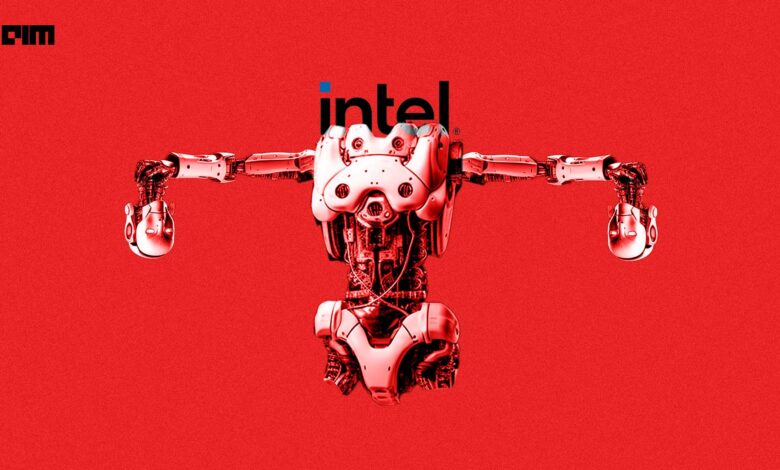Intel Slips As Chipmaker Falls Behind In AI Race; Which Are The Leading Companies Vying For $3.5 And $5.8 Trillion Annual AI Market
Intel, a major player in the semiconductor industry, witnessed a significant setback as its shares plunged by over 12% following a bleak revenue forecast for the first quarter. As AI gathers more traction, important players like Intel are vying for dominance; however, the decline reflects Intel's struggle to keep pace in the dynamic field of artificial intelligence (AI) and its challenges in the PC market. While AI innovation propels growth in the chip sector, Intel's apparent lag behind competitors raises concerns about its future competitiveness.

Intel saw a significant decline of more than 12% on Friday, prompted by a discouraging first-quarter revenue forecast.
The decline reflects the company’s struggle to keep pace in the rapidly evolving field of artificial intelligence (AI), compounded by challenges in the PC market.
While AI innovation propels growth in the chip industry, Intel appears to lag behind, a departure from the success enjoyed by other semiconductor manufacturers catering to AI’s data-intensive demands, which flourished in the stock market throughout 2023.

The Effect
The dim outlook from Intel, a major supplier of PC chips, cast a shadow over the entire sector, with the Philadelphia SE Semiconductor Index experiencing a 2.7% dip, marking its most significant single-day decline in over three weeks.
Analysts, such as Hans Mosesmann from Rosenblatt Securities, noted Intel’s conspicuous absence from the AI sector and expressed concerns about another potentially transitional year for the company.
The setback was not just limited to Intel but led to losses for other chipmakers, including Nvidia, Advanced Micro Devices (AMD), Qualcomm, and Micron Technology, with their shares declining between 1.3% and 2.8%.
Intel’s market value plummeted by approximately $24.9 billion, eroding gains made during the previous year when its shares surged by 90%.
The company’s projection for the current quarter suggests revenue could fall short of market estimates by over $2 billion, raising apprehensions about Intel falling behind competitors like Nvidia and AMD, whose chips are increasingly vital in the AI sector.
Despite Intel’s current struggles in the AI chip market, its central processing units (CPUs) often complement Nvidia’s AI chips, with a notable portion of Intel’s server CPUs integrated into AI systems.
While some analysts express optimism about Intel’s future, evidenced by at least 15 brokerages raising price targets, the median price sits at $44 according to LSEG data.
Thomas Monteiro, a senior analyst at Investing.com, highlighted the potential long-term gains from Intel’s AI investments, suggesting that CEO Pat Gelsinger’s strategy remains intact, albeit with a slower execution pace.
Intel’s stock valuation, trading at approximately 28 times its 12-month forward earnings estimates, contrasts with AMD’s 45.08 and Nvidia’s nearly 30, as per LSEG data.

The AI Race
In the intense competition for dominance in the realm of Artificial Intelligence (AI), discerning the frontrunner remains a challenge; however, if we were to draw parallels from past technological battles, it may offer insights into predicting the eventual winner.
Among the frontrunners are prominent names like IBM, Google, Baidu, Alphabet, Facebook, Microsoft, Nvidia, Apple, Meta, Amazon, Open AI, and Adobe, poised to shape the future of AI.
Yet, akin to the VHS versus Betamax rivalry, it’s uncertain which contender will emerge victorious, necessitating hindsight to gauge the dominant force in AI.
However, research by Xavier Ferràs-Hernández (Esade), Petra A. Nylund (University of Stuttgart), and Alexander Brem (University of Stugggart and University of Southern Denmark), published in the California Management Review, illuminates the dynamics of AI in business and identifies potential frontrunners.
Through an exhaustive literature review and analysis of previous managerial frameworks, the researchers have pinpointed the designs and business models likely to dominate the AI market. Their findings offer valuable insights for firms and managers seeking to gain a competitive edge.

What Is At Stake
With trillions of dollars at stake, AI stands as the most transformative technological advancement in recent times, projected to generate annual revenues ranging from $3.5 to $5.8 trillion across various industries.
At the same time, uncertainties persist regarding the formation of value chains and the eventual dominance of specific designs. For example, throughout history, it has been understood that superior technical designs may not always translate into market adoption.
The emergence of a dominant platform hinges on striking a balance between open architecture and closed innovations and overly specific or resource-intensive systems, closed standards, and customized solutions pose significant hurdles in the race for supremacy.
Additionally, service and business model innovations play pivotal roles in shaping the trajectory of market leadership in AI.

AI, Disruptive Technology
Disruptive technology, true to its name, disrupts markets by introducing novel dynamics.
During its nascent stages, various configurations emerge, each targeting specific niches within the market while supply chains oscillate between vertical and horizontal modular architectures until a dominant player asserts itself.
Vertical industries emphasize core competencies without impeding competition’s entry into the supply chain. Conversely, modular industries pursue efficiency and control via verticalization strategies, where crucial competencies like processors, research and development (R&D), and talent serve as incentives for vertical expansion.
Presently, AI finds itself in a modularized configuration, lacking a definitive dominant architecture, and the integration of leading entities and their methodologies could pave the way for the emergence of a frontrunner.
The Historical Trends
In the AI market’s current state, fluidity prevails, with mass market penetration yet to materialize, and no clear frontrunner evident.
Historical precedent indicates that during this phase, startups vie for position alongside established corporations. Stability typically arrives with the market’s preference for a specific design, akin to IBM’s dominance in the personal computer market and Apple’s ubiquitous iPhone.
As the AI market matures, it is expected to introduce more sophisticated human-machine interface systems with enhanced social capabilities and strategic thinking skills. Despite its early stage, Ferràs and colleagues identify one promising business avenue for a mass market: delivering AI through cloud services.

How Cloud Services Could Pave The Way
Reflecting on past market shifts, such as Intel’s triumph in the PC market during the late eighties and early nineties, it’s predicted that market leaders will spearhead AI supercomputing facilities.
These facilities will enable retailers, manufacturers, and service providers to access advanced AI functionalities like image recognition, facial recognition, speech generation, and strategic thinking via terminals.
Cloud supercomputing facilities, powered by cutting-edge GPUs, will facilitate the provision of AI as a service, akin to the ‘Intel Inside’ campaign’s impact on personal computer manufacturing.
The evolution could lead to consumer goods embedded with AI technology from household names like ‘Google Inside,’ ‘Amazon Inside,’ or ‘Microsoft Inside,’ along with Facebook and Baidu.
These companies have already embraced open-source software to foster a horizontal market of external developers, reminiscent of Intel CPUs’ role in driving mass production of personal computers.
AI delivered as a cloud service, known as AI as a service (AIS), is emerging as a dominant business model. Amazon Web Services (AWS), equipped with specialized AI libraries, commands a valuation of $130 billion, capturing a dominant 32 percent share of the global cloud market.
Microsoft’s Azure, boasting over 20 cloud-based cognitive services, holds a 20 percent share, while Google Cloud, with its array of application libraries for tasks such as image processing, natural language processing, speech recognition, and intelligent data searching, claims a nine percent stake.

The global cloud market is projected to expand significantly, reaching a staggering $1,026 billion by 2026.
Apple adopts a ‘final user device’ strategy, restricting its cloud capabilities to its proprietary devices. NVIDIA, too, offers cloud solutions but delivers its machine intelligence services through partner cloud platforms such as Google, IBM, Microsoft, and Amazon.
Upskilling For Relevance
The job market aligns with the trajectory of emerging technologies, witnessing a surge in demand for AI engineering roles, with a remarkable 344% growth observed in the US between 2015 and 2018.
Companies like Amazon, Google, and Microsoft have made substantial investments in talent specializing in AI, with Amazon leading with a $228 million investment, followed by Google with $130 million and Microsoft with $75 million.
As the demand for AI expertise rises, organizations must prioritize training and development initiatives to leverage the competitive advantages AI offers. Transitioning towards an AI-driven environment requires comprehensive organizational readiness, a process that unfolds gradually.
AI as a service empowers managers to extract insights free from human biases, unlocking limitless potential applications. Consequently, data strategies assume paramount importance in operational frameworks, enabling vastly improved predictive capabilities and perspectives.
/2023/09/28/image/jpeg/MXYYGjoX4W8DzvPyOrUTc38RRejn6VoEwjNGcwBx.jpg)
The Last Bit, In the domain of artificial intelligence (AI), a fierce competition is unfolding as companies vie for market dominance.
Amidst this technological revolution, industry giants such as NVIDIA, Microsoft, Google and many more are engaged in a heated battle, each striving to secure a significant share of the rapidly expanding AI market.
The intense rivalry indicates AI’s critical role in shaping the future of industries worldwide, prompting innovative strategies and investments from various contenders eager to assert their supremacy in this transformative landscape.
The emerging paradigm of AI delivered through cloud services, exemplified by AIS (AI as a service), is reshaping the business landscape.
AWS, Microsoft Azure, and Google Cloud are at the forefront, driving innovation and capturing substantial market shares.
The trend is projected to fuel exponential growth in the global cloud market, providing opportunities for businesses to harness AI capabilities.
Moreover, the surge in AI engineering roles underscores the importance of organizational readiness and investment in talent development. As companies adapt to this AI-driven future, they stand to unlock unparalleled potential for growth and innovation.




